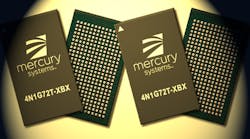BuiltSecure high-density secure memory devices from Mercury Systems use 3D packaging techniques to embed 8 GB of high-speed double data rate fourth-generation synchronous dynamic random-access memory (DDR4 SDRAM) in compact ball-grid-array (BGA) packages measuring just 13 × 20 mm. The packages are designed for high reliability in harsh military environments. These memory devices are being integrated into a next-generation computing system for a military avionics command, control, and intelligence (C2I) application
The 3D packaging technology transforms a planar array of nine discrete DDR4 memory devices into a single, size, weight, and power (SWaP) efficient and vertically integrated memory solution with DDR4 performance over an extended operating temperature range of −55 to +125ºC. The low-profile BGA memory devices (see photo) are less than 2.5 mm high and can be mounted on the backside of a printed-circuit board (PCB) in space-critical applications.
“After announcing our DDR4 design program in March of this year, we received a tremendous response from defense prime contractors in need of highly miniaturized and ruggedized DDR4 memory solutions with data transfer rates up to 2,666 MB/s,” said Iain Mackie, vice president and general manager of Mercury’s Microelectronics Secure Solutions group. “Leveraging our 15-year heritage in microelectronics packaging, we successfully accelerated our DDR4 development program to align our first product shipment with the needs of this critical military program’s schedule.”
The BuiltSecure high-density secure memory devices are designed and manufactured at Mercury’s Defense Microelectronics Activity (DMEA) trusted Advanced Microelectronics Center (Phoenix, Ariz.). For long-term supply continuity, critical components are acquired from carefully selected supply chain partners with manufacturing sites located within the U.S.

